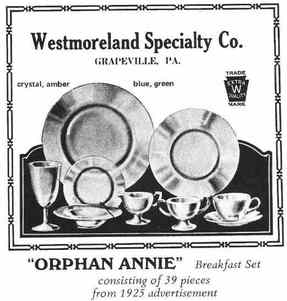Orphan Annie visits the Fairground
One of the constant joys of Carnival is that there are stories behind the glass. The dainty marigold Chippendale-handled sugar and creamer above seem fairly ordinary at first glance, but their appearance is deceptive. Look closely at the photo above; on the marigold sugar (left) you can make out the words Mt. Clemens. On the other side of the piece is the date 1909. What’s the story there? And what’s the pattern? What’s its name? Who made it? Let’s find out.
|
Back in 2008, a UK collector found a creamer just like the one above.
Delving into the history of the piece we found that it is a Westmoreland item (the creamer was Westmoreland's #294, the handled sugar being #295). In 1974, Mrs Weatherman ("Colored Glassware of the Depression Era2") showed the 1925 advert for the Westmoreland Specialty Co. (right). The caption “ORPHAN ANNIE" was added by Weatherman and we can’t be certain if she gave it that name, or if she had seen it on another Westmoreland ad. In 1982 in “The Glass Collector” William Heacock showed the breakfast set in amethyst Carnival. He followed Weatherman’s name, “Orphan Annie”. Finally, also in the 1980s, Ray Notley showed the sugar and creamer (in black and white, without noting the colour) and gave it the name “ Cairo”, perhaps because the early ads referred to "Egyptian design"? |
|
The ad on the left is from a Butler Brothers catalogue of 1908 and shows the sugar and creamer surrounded by other Westmoreland items (including “Estate” pieces). It is interesting to note that the ad’s description mentions a solid gold lining—the same feature, a gold lining, is also mentioned on another Butler Brothers 1908 ad for the sugar and cream jug alone (see ad, top left). The “gold lining” was the gold effect iridescence inside the items.
Chas West Wilson (“Westmoreland Glass” Collector Books, 1996) explains that the gold and sometimes silver iridescent effect on these items was caused by a temperature difference in the glass. In his book he shows an amethyst sugar and creamer—the creamer has a silver iridescence inside while the sugar has a pinkish golden iridescence inside. West Wilson explains: “while both sugar and creamer were about 1000 degrees F when sprayed, the temperature of the gold sugar was slightly cooler than the silver creamer”. |
Now let’s go back to that splendid handled sugar at the top of this article that has the words Mt. Clemens 1909 etched onto it. Another UK collector spotted this and promptly did some sleuthing.
|
Why Mt. Clemens? What’s so special about this city in Michigan? And what is significant about the 1909 date? The answer is fascinating! On July 4th, 1909 (Independence Day) a new, wooden roller coaster called “Leap the Dips” opened at Mt. Clemens, with the fanfare: “More Fun for 10 cents than you will get otherwise in 100 years!” A postcard of it is shown, left, courtesy of WaterWinterWonderland.com. Clearly the Westmoreland Carnival items were marketed as being suitable for souvenir lettering, and the Mt. Clemens items were made bearing the name and date, 1909, when the roller coaster opened. Fun on Leap the Dips and a take-home Carnival Glass souvenir too!. |
We also know of other items in the “Orphan Annie” pattern with souvenir lettering, for example, “Souvenir of Allentown”.
Shown here on the left are an Orphan Annie sugar and creamer in amethyst. The sugar has the lettering "Mother 1921" and the sugar "Lulu 1921". Courtesy of Seeck Auctions. |
Read more of The Stories Behind The Glass in Carnival Glass Times






